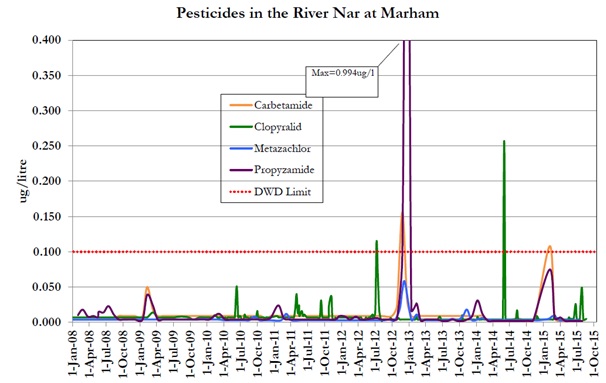It is now the time of year when there is concern about pesticides moving to water and exceeding the challenging limits specified in the Drinking Water Directive. The maximum level for an individual pesticide is 0.1 µg/l (0.1 parts per billion) when measured at the tap i.e. after processing at the water works. This is not based on risk to human health and the environment but the limit of detection when the Directive was first introduced. The industry has long argued against this limit but I suspect that it is here to stay.
The real concern at this time of year centres on the slug pellet metaldehyde and the oilseed rape herbicides carbetamide and propyzamide. Metaldehyde cannot be removed from water by the processes that are adopted in water treatment works. On the other hand, with these oilseed rape herbicides any small exceedances of the level specified in the Drinking Water Directive can be reduced by water treatment to meet the requirements. The real problem is the large spikes of concentrations in the water following rainfall shortly after application. An example is given in the graph below, in this case propyzamide. Without these herbicides it would be difficult or impossible to grow winter oilseed rape in the vast majority of situations and so a solution has to be found or the area of oilseed rape grown in the UK could be significantly reduced.

There is a huge effort being made by the pesticide manufacturers and The Voluntary Initiative to provide guidelines on how to reduce levels in raw potable water. This involves the use of buffer strips, identifying high risk fields, weather forecasting and specifying best practice etc. However, it is a difficult problem to overcome.
There can be conflict between getting good pesticide activity and reducing environmental impact: propyzamide offers a good example. The requirements for good activity are a moist and cool soil. This means that applications are made as soon as the conditions are suitable, often in early to mid-November. Not only are soils already moist at application but the fact that everyone tends to spray in a small window means that large peaks in the content of propyzamide can occur in raw potable water. Such peaks have resulted in water treatment works being closed down for a couple of weeks.
So, what is to be done? I recently attended the BCPC Brighton Congress and the session on the Water Framework Directive (that includes the Drinking Water Directive) provided some direction. There was a brilliant talk by the lead catchment scientist of a very large UK water company. This included targets for their catchment management initiatives. It is the first time I have heard a water company declare their targets and such statements are a real help to those working to reduce pesticide movement to water.
One target is that the maximum levels of metaldehyde in raw potable water should not exceed the 0.1 µg/l limit. It is a sensible target because this pesticide cannot be removed at the water works. The second target is to reduce peak pesticide peaks in water by half. In my opinion this is a realistic target and, if it is shared by other water companies, gives me hope that the industry can rise to the challenge without too much disruption.
All the current and future initiatives on the management of those herbicides which are likely to move to water should, if adopted, enable us to creep closer to reducing pesticide peaks by half. Notice that I said ‘if adopted’. The water companies are still supporting voluntary measures but these have to reap results. Unfortunately, this may mean that some farmers will have to compromise on cropping choice and management if they have high risk fields. However, there may be alternative ways of tackling the problem which could result in less disruption to farmers. I will investigate these in a later blog.
